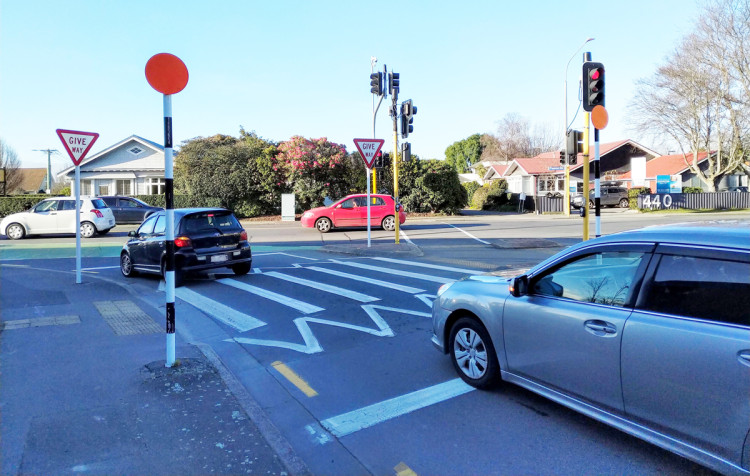A left turn slip lane is a lane separated from an adjacent lane by a marked or raised triangular island. Slip lanes are provided at an intersection with a view to improving the safety of drivers and passengers in vehicles, minimise delays to through vehicles or to ease the turning movement where the angle of the intersection would result in an otherwise difficult movement. Bypass lanes at roundabouts may be considered as a special case of left turn slip lane.
Slip lanes may be used at the following locations in rural settings where walking, wheeling and cycling are less prevalent:

Raised zebra crossing on a left turn slip lane, Blighs Road, Christchurch. (Photo: Ben Jassin)
In urban areas, slip lanes (and those at roundabouts) are not recommended and other intersection layouts should be considered. Slip lanes have various disbenefits to people walking, wheeling, and cycling. Slip lanes increase the exposure risk to serious injuries and encourage drivers not to slow down when approaching the intersection; they increase the crossing distance and time for people walking and wheeling; and limit the volume capacity of people waiting to cross. These disbenefits can still occur even when some forms of pedestrian crossing facility are provided on the slip lane.
There are no specific legal considerations for slip lanes.
Slip lanes are not recommended in urban areas and other intersection layouts should be considered. When planning and designing improvements to existing slip lanes after exhaustedly assessing opportunities to change the layout of the intersection, the following should be considered to assist pedestrian movements:
Selecting an appropriate crossing facility type across the slip lane requires a context sensitive approach. The Pedestrian crossing selection guidance note outlines a recommended crossing selection process.
PNG: Crossing selection process
On most intersections with a slip lane there will be three crossing places for pedestrians: Across the left turn slip lane, across the through and right turning lanes, and across the intersecting road. It is important in the design stage that any platform ties in with the adjoining waiting space in the island and beyond to the crossing of the traffic lanes so that the route is accessible by all including those in wheelchairs or using mobility devices or caregivers pushing prams.
Where a slip lane island also functions as a place for pedestrians to wait while crossing the road, tactile indicators should be provided as in the photo below. The pedestrian area should be well defined with kerbing or planting as a guidance cue. If not, then use directional tactiles to guide pedestrians. The size of the island must be able to accommodate the anticipated pedestrian volumes and allow extra space for people using wheelchairs and pushchairs.

Slip lane with raised platform, tactile indicators and level surfaces through the islands. (Photo: Gemma Dioni)
On large slip lane islands that do not have a direct cut through, directional tactile indicators should be used between the crossing points to provide directional guidance to pedestrians who are blind or have low vision.
Where there are three crossing points on a large slip lane island, directional indicators should lead to a central warning indicator with dimensions of 600 x 600mm to indicate that a choice becomes available.